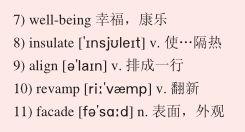“垂直花园”——反重力的绿色艺术
2013-08-01byAngelaFedele
by Angela Fedele
A growing number of small urban spaces are creating landscaped gardens that stretch beyond floor pots, with greenery growing upwards along walls and fences.
This new trend toward “vertical gardens”is renewing apartments, offices and restaurants inviting greenery to flourish in small spaces.
Vertical gardens, also referred as “eco walls”or “green walls”, are bringing practical and aesthetic value to both domestic and commercial spaces. Along with their environmental benefits, plants and greenery can also improve air quality and promote health and wellness.
This sustainable form of architecture also supports the 1)biophilia hypothesis, a suggestion that there is an innate connection between human beings and living systems.
According to Susan McCoy of the U.S. based trend-spotting Garden Media Group, this new generation of gardeners is composed of environmentally-conscious Gen X and Gen Y types who believe the power of plants and regard plants is “no longer a luxury, but a necessity for our lives.”
Plants can be arranged on the side of a building, on fences and walls both internally and 2)externally. When placed strategically, vertical gardens make for great design features and are considered alternatives for wall art.
Walls and fences should be structurally strong to grow a vertical garden as theyre generally designed to be 3)permanent structures. It is advised that professionals versed in engineering, design, building regulations, draining and 4)horticulture be the ones to install them.
In terms of design, some organisations offer vegetated panels that can be attached or plants that can be placed in decorative containers in a grid-inspired format along the wall. Choosing vegetation for garden installation should be based on location and maintenance requirements.
For ease of maintenance, it is advisable to have a built-in irrigation system and a good drainage system nearby. Vertical gardens generally require self-watering irrigation systems, as manual 5)hosing will result in water simply running into the ground. 6)Hydroponic watering systems can also be installed to keep plants fed and fresh.
Installing a vertical garden inside is a great way to connect an interior space with nature. Interior greenery requires a little more attention as adequate lighting and ventilation may need to be installed. The wall and surrounding areas should also be waterproofed and actively kept dry.
Commercially, plants are being invited into offices, restaurants and high-end hotels. “With most large offices having few windows and little natural light, insightful office managers often use plants to bring freshness and colour to the office environment, but the benefits go further than this. “Research strongly suggests that plants can result in improved 7)well-being among staff, increased productivity and improved air quality,” said UK psychologist Dr Craig Knight.
Covering a building wall can keep the wall 8)insulated, alleviate pollution and provides a shield to the building materials from elements like the sun.
愈来愈多的狭小城市空间正将花园景观建造于地面以外的地方,把绿色植物种植在围墙和栅栏上。
这种建造“垂直花园”的新潮流,使得公寓、办公室和餐厅焕然一新,令怡人的绿色植物得以在狭小的空间里繁茂生长。
垂直花园,也叫“生态墙”或是“绿色墙”,给住宅和商业空间带来了实用和审美价值。除了其景观效益之外,花卉和绿色植物还能够改善空气质量和促进人体健康。
这种可持续的建筑形式也成为“亲生命性假说”的力证,这种学说认为人类和生态环境之间有着内在的联系。
苏珊·麦考伊来自紧贴潮流的美国公司——花园传媒集团,她说,新生代的园艺大师都是由具有环境意识的X世代和Y世代组成的,他们相信植物的力量,认为植物“对于我们的生活来说,将不再是一种奢侈,而是必需品”。
植物可以种植在建筑物的边上,在栅栏或者是围墙的外围和里面。如果种植得当,垂直花园将会成为显著的设计特征,甚至会成为墙艺中的优选方案。
用来种植垂直花园的围墙和栅栏在结构上必须足够牢固,因为它们一般会设计成永久性结构。有人建议由精通工程、设计、建筑条例、排水和园艺的专业人士共同来建造垂直花园。
从设计的角度来讲,一些机构提供可以附挂墙身的植物饰板,或者将植物种植在装饰性容器中,再以网格形式排列置于墙身。园艺设施中植物的选择则应该依据所在位置和养护需求来定夺。
而为了易于维护,有人建议内置浇灌系统,并且在附近建造良好的排水系统。垂直花园一般要求自动浇水灌溉系统,因为人工以软管浇洒只会导致水流满地。水培浇灌系统也同样可以维持植物滋养、鲜艳。
在建筑内部安装一个垂直花园是将室内空间和自然联系起来的有效方法。室内的绿色植物需要更多的关注,因为充足的采光和通风设备是必须的。围墙和周边地区必须是防水的,必须能够时刻保持干燥。
从商业上来讲,植物正被引入到办公室、餐馆和高端的酒店当中。“由于大多数的大办公室都几乎没有窗户,没有充足的自然光线,富有洞察力的办公室管理者通常使用植物来增加清新感,为办公室增添色彩,但是植物所带来的效益远非仅此而已。“有研究强有力地表明植物可以改善员工的幸福感,提高生产效率和空气质量,”英国心理学家克雷格·奈特博士这么说道。
使用植物覆盖建筑物围墙可以为墙身制造隔热层,减少污染,同时为建筑材料提供保护,免受诸如太阳的损耗。
一头标志性的绿色头发,衬衫上印着野生植物的图案,他便是“垂直花园”的创始人——帕特里克·布兰克(Patrick Blanc)。
布兰克1953年出生于巴黎,他那著名的植物墙的概念来自于自己的鱼缸。在他还是个孩子的时候就发现植物可以在水中生长,他马上就意识到植物的生长不一定完全依赖土壤。经过多年的实践,他试验成功了一种方法:活的植物墙。
他的首座“植物墙”工程完成于1988年的巴黎工业及科学城温室里;1994年,布兰克在法国卢瓦尔蒙肖国际花园节中,展出了两座独树一格的垂直花园,令观众惊艳,由此引起外界关注。布兰克的其他著名的垂直花园作品包括葡萄牙里斯本一家购物中心内的垂直花园,泰国曼谷的百丽宫购物中心,科威特城的一座政府建筑。布兰克所设计的面积最大的垂直花园位于巴黎的阿尔萨斯大街,其覆盖面积达到15000平方英尺。此外,上海兰餐厅内的绿墙也出自他的手笔。
In New York, architect Laurence Tamaccio is proposing to cover the West Side Highway—the divider between Riverside Park South and the Hudson River—with a leafy vertical ivy garden and 9)aligning waterfalls. He believes his Vine Line proposal will become a source of pride for the entire community and 10)revamp the area aesthetically.
Near Milan, meanwhile, a shopping centre is claiming to have the biggest vertical garden in the world, with 1,263 square metres adorned with a total of 44,000 plants. It was designed by architect Francesco Bollani who said“it took us a year to grow the plants in a greenhouse and 90 days to build the 11)facade.”
The previous record was held by a Madrid garden covering 844 square metres.
在纽约,建筑师劳伦斯·塔马乔正提议将西侧高速公路——河滨公园南和哈德逊河之间的分隔物——覆盖上一个枝繁叶茂的垂直常春藤花园和垂直瀑布。他相信自己的“绿藤前线”提议将成为整个社区的骄傲,而且将会使整个地区变得更加美观。
与此同时,在米兰附近,一个购物中心声称将拥有世界上最大型的垂直花园,面积达到1,263平方米,共使用44,000株植物来装饰。此垂直花园是由建筑师弗朗西斯科·博拉尼设计的,他说:“我们花了一年的时间在温室中种植植物,而外墙的搭建则花了90天。”
在此之前,这一记录是由西班牙马德里的一个面积844平方米的花园所保持的。
